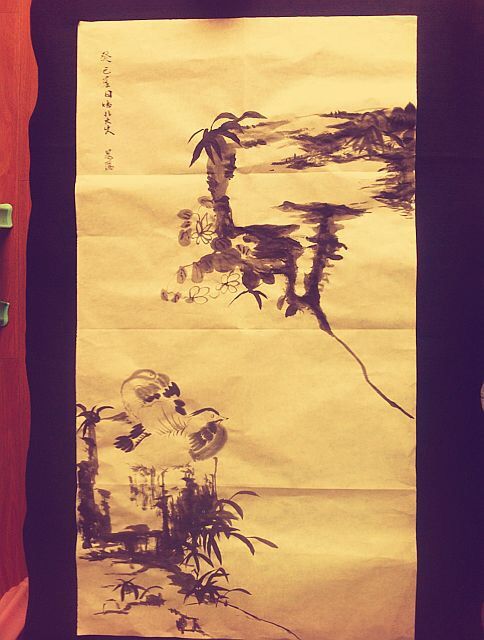
In this piece, I use simple things to show a simplicity and loneliness. My favorite piece in this genre is the work of Zhu Yong.This work is a genuine auction price of 118.7 million yuan.my Favourite!
Zhu Da [Chu Ta; Chuanqi; hao Bada Shanren, Pa-ta Shan-jen]
(b 1626, Nanchang, Jiangxi Province; d 1705).
Chinese painter and poet. A descendant of the imperial Zhu family of the Ming dynasty (1368–1644) and a leading artist of the early Qing period (1644–1911), Zhu Da painted flowers, birds and landscapes in a distinctive and highly dramatic calligraphic style. His connections with the previous dynasty led him to flee Nanchang after the Manchu conquest of China in 1644. Adopting the sobriquet Chuanqi, Zhu Da became a Buddhist priest and soon a respected Buddhist master, quickly attaining the position of abbot. He also became an accomplished poet and painter; his earliest extant work is an album of 15 leaves (1659; Taipei, National Palace Museum). In 1672, after the death of his Buddhist master, Abbot Hong min, Zhu Da relinquished his solitary monastic existence to pursue his fortune as an itinerant monk-artist. He joined the coterie of Hu Yitang, magistrate of Linchuan County, and participated in the splendid poetry parties held in 1679 and 1680. Zhu Da was thwarted in his attempts to take up an official career because of his imperial lineage and in 1680 was devastated by the departure of his patron Hu Yitang. Reportedly, Zhu Da went mad; one day, laughing and crying uncontrollably, he tore off his priest’s robe and set it on fire. The burning of the robe signaled the end of Zhu Da’s life as a Buddhist monk, and from then on he lived as an itinerant painter. Between 1681 and 1684 he called himself Lu (‘donkey’ or ‘ass’), a derogatory name for monks, or Lu hu (‘donkey house’); from 1684 onwards he called himself Bada Shanren (‘Mountain man of eight greatnesses’). Zhu Da adopted other names throughout his life, many reflecting his state of mind or his loyalty to the Ming dynasty. Of these, only a few (such as Chuanqi, which identifies his earliest extant work) were used as signatures, the most common being Bada Shanren.
Zhu Da developed a school of freehand brushwork in traditional Chinese painting and became an outstanding painter and Taoism believer. The individualism of his ink paintings of flowers, birds, fish, and landscapes appealed to the Japanese, and his style has become synonymous with Zen painting in Japan. There is an Art Gallery of Bada Shanren in a southern suburb of Nanchang. The gallery was once a Taoist temple called Qingyunpu and legend says that 2,500 years ago Qiao, son of Emperor Ling of the Zhou dynasty (1100-221BC) came here to seek a way to produce pills that would make him immortal.
What a amazing!
Downvoting a post can decrease pending rewards and make it less visible. Common reasons:
Submit
Hi! I am a robot. I just upvoted you! I found similar content that readers might be interested in:
https://www.burchfieldpenney.org/general/blog/article:09-29-2015-12-00am-metaphors-of-the-bird-image-in-ba-da-shan-ren-s-painting-by-ziwei-wang/
Downvoting a post can decrease pending rewards and make it less visible. Common reasons:
Submit